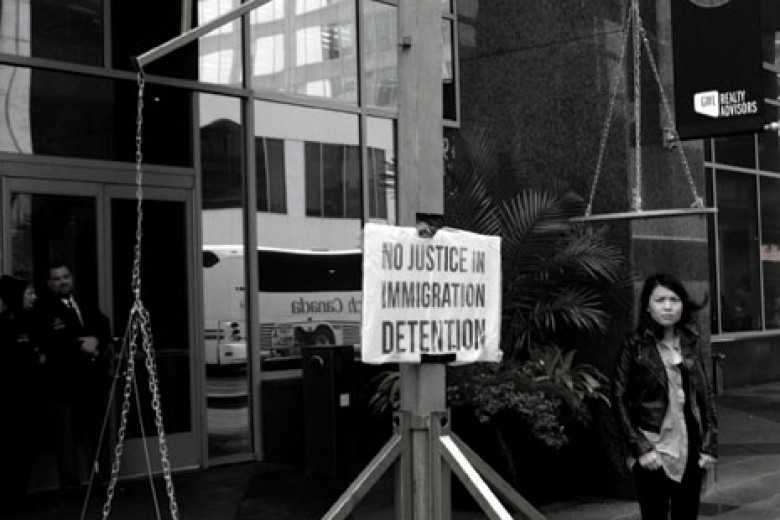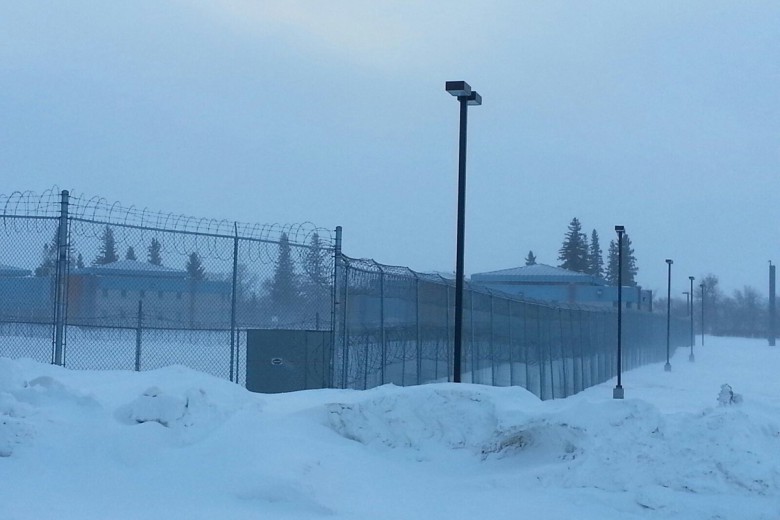It’s late May, a Friday and the fourth day of Canadian Union of Public Employees (CUPE) Ontario’s 2025 convention. As the minutes tick toward five o’clock and the meeting draws to a close, quorum is slipping away. Anticipating their long commutes, delegates from across the province are trickling out to beat the traffic – a nerve-racking situation for anyone with a motion yet to be decided on.
But Ashlee Verma, co-chief steward of CUPE Local 1281, a small union that represents about 300 individual members, wasn’t worried as she watched people line up behind the designated “pro” microphones in the Sheraton Centre Toronto Hotel’s Grand Ballroom to speak on Local 1281’s emergency resolution on prison labour. Two “pro” mics and two “con” mics were set up on either side of the hall so speakers could access whichever one was closest to them, depending on whether they wished to speak for or against the proposal at hand.
Not one of the approximately 1,000 attendees stood behind a “con” mic.
“It got so much of a positive reaction,” says Verma, who wrote the rationale for the resolution. “So much so that I didn’t even ultimately get to speak on it.”
Full labour rights
Local1281 was compelled to act when it learned in May that CORCAN, the agency within Correctional Service Canada (CSC) that provides work and training to federal prisoners, was expanding its wildfire safety program from the Prairies into Ontario. Since the deadline to submit resolutions for debate at the CUPE Ontario convention had already passed, they drafted a strongly worded emergency resolution, a type of resolution designed to address matters that may crop up between the deadline and the start of the convention, condemning Canada’s increasing reliance on prison labour.
CORCAN pay maxes out at $6.90 per day, but most federal prisoners take home less than $3 a day after mandatory deductions for things like their food and accommodation, the phone system, an inmate welfare fund and a meagre savings plan for after their release.
The resolution called on CUPE Ontario to condemn coercive prison labour, and to advocate for its end through public statements, lobbying efforts, and education. It also urges investment in publicly delivered emergency services staffed by fairly paid workers with full labour rights and calls for collaboration with prisoner advocacy groups to ensure incarcerated individuals are treated with dignity and respect.
CORCAN pay maxes out at $6.90 per day, but most federal prisoners take home less than $3 a day after mandatory deductions for things like their food and accommodation, the phone system, an inmate welfare fund and a meagre savings plan for after their release. They’re also not considered employees under labour law because their work is considered part of their rehabilitation, making them some of the most vulnerable workers in the country. Carve-outs like these undermine the basis of minimum labour standards and rights for everyone.
“This follows an exploitative model which does not protect public safety,” charged Local 1281 in a news item posted on its website that announced the successful passing of their emergency resolution. “Prisoners deserve full labour rights and [Ontarians] deserve real climate responses.”
The resolution passed with applause from delegates, and was expected to be presented at the CUPE National convention in early October. However, according to a source at CUPE 1281, there wasn’t enough time to get to all of the resolutions during the national convention. Leftover resolutions – including the one on prison labour – are referred to the national executive board.
The carceral Left
Jordan House is an assistant professor of labour studies at Brock University who has extensively researched prison labour in Canada. His first response to learning that Local 1281’s emergency resolution had passed? Surprise.
“It's very rare that the Canadian labour movement has commented on prison labour at all in the last several decades,” he says. “I thought it was a very positive development.”
It came at an important time for all the reasons that the resolution lays out, House explains. “If there’s going to be this expansion of prison labour utilized in response to climate change and this need for labour to mitigate climate disasters, then this is certainly an issue for public-sector unions. You know, it raises all sorts of questions about what the public sector is for.”
Despite a common interest with prisoners in strengthening labour rights, public-sector unions have in some cases advocated to expand punishment to the detriment of the social safety net, according to Bronwyn Dobchuk-Land and James Wilt in a 2020 article for Briarpatch. For instance, the Manitoba Government and General Employees’ Union, which represents about 32,000 workers, has become “the leading advocate of jail-building in the province even though correctional officers have only ever made up 5 per cent or so of its membership.” The pair argue that the rise of the social democratic left’s involvement in policing and jails “provides clues about what happens when lines are drawn (and walls are built) between those who are imagined as deserving of solidarity and those who aren’t.”
On May 23, CSC announced that CORCAN planned to expand its wildfire safety training program into Ontario for summer 2025. The program had already been operating in the Prairie region since the spring of 2024, and according to an emailed statement from CSC, currently operates in Saskatchewan, Alberta, and British Columbia. The Ontario expansion was to begin in October.
“The purpose of the program,” according to CSC’s statement, “is to equip offenders with the skills necessary to pursue post-release employment in this field, should they choose.”
The “Type 3” training provided by CORCAN is an introductory level that would equip “an ad-hoc fire-fighting force with the basic skills needed to provide support, mop-up and patrol operations when wildfires have been contained.” Over the course of five days, only one of which is in the field, students learn fire behaviour, trenching, how to use a firehose, and how to maintain their own safety while fighting fires. So far, 36 prisoners have received the training in Saskatchewan, 15 in Alberta, and 30 in British Columbia. Nine prisoners enrolled for training at Collins Bay Institution in Ontario in October.
But some see the training program as a signal that Canada may follow in California’s footsteps in using prison labourers to deal with climate disasters.
As House and Lydia Dobson, a lawyer and law professor at the University of Ottawa, write in The Conversation, the United States has increasingly responded to environmental disasters like fires and floods by sending prisoners to the front lines. Early this year, the nearly 950 California inmates who fought the Los Angeles fires with non-incarcerated fire crew earned only about $10 a day for their equally dangerous and courageous work. Aside from poor wages, incarcerated fire workers are much more likely to be injured on the job or suffer from smoke inhalation than their professional counterparts.
There is reason to worry that, once trained, Canadian federal prisoners could find themselves fighting wildfires prior to their release. Provincial prisoners in British Columbia already support firefighting crews by maintaining and inspecting equipment and camps.
Through its fire camp program, the California Department of Corrections and Rehabilitation allows incarcerated people to reduce their sentences by serving as firefighters. A similar reward is not offered in Canada. In fact, there is no mechanism whereby a federal sentence can be shortened based on a prisoner’s good behaviour – this practice ended in 1992 – though once two-thirds of a fixed-length sentence is served they may be released under supervision.
Prisoners in federal custody do, however, face all sorts of coercion in relation to their labour. Correctional plans, which each federal prisoner serving two or more years receives at the start of their sentence, have employment built into them. That means, says House, that “every prisoner in federal custody has to work and has to work to the satisfaction of the administration if they are going to have a reasonable chance at early release.” Failure to perform work can result in administrative sanctions, he explains.
For its part, CSC insists that its “offender employment programs operate under the principle of free consent and do not occur under the threat of penalty.”
Even though the choice to participate in wildfire training is offered, Verma wonders if prisoners “know what they’re getting into based on what they’re being sold.”
There is reason to worry that, once trained, Canadian federal prisoners could find themselves fighting wildfires prior to their release. Provincial prisoners in British Columbia already support firefighting crews by maintaining and inspecting equipment and camps. And prison labour has been used in response to wildfires in Ontario from the late 1960s through to the mid-1970s.
Identity
Still, some incarcerated fire crew members have told the media that they’d rather be fighting fires than sitting in a cell. Though many prisoners describe their labour as akin to modern slavery or indentured servitude due to their poor pay and lack of freedom to refuse to work, House explains that some prisoners report that firefighting is very rewarding.
“It’s skilled labour, and despite the fact that they’re prisoners, they do get some level of [recognition] as firefighters, and that’s all powerful and important to people,” he says.
Philip Goodman, a sociology professor at the University of Toronto, interviewed 45 prisoners, 12 officers, six forestry crew leaders, six correctional supervisors, and two administrators across five of California’s fire camps for his seminal 2012 scholarly paper, “Hero and Inmate: Work, Prisons, and Punishment in California’s Fire Camps”. Goodman found that typical sentiment about prison labour – namely, that it is exploitative due to poor wages and poor labour rights – cannot be broadly applied in the case of wildfire fighting, because workers can find their labour both exploitative and rewarding. While he found a sense that prisoner fire crews worked harder, were made to do less desirable work (such as mop-up) than their non-incarcerated teammates, and were sometimes even treated poorly by them, they also told him that they saw their work in the fire camps as giving back and a way to gain career skills. Beyond that, they were proud of their work saving property and sometimes lives.
“Many camp inmates view the work they perform as simultaneously heroic, dignified work and a form of labor exploitation,” he writes.
Still, whether prisoners take pride in their work, they should not exist as a convenient and cheap source of labour for the state.
Until her comrade in Local 1281 proposed bringing the emergency resolution on prison labour to the CUPE Ontario convention, Verma hadn’t been involved in any other prisoner advocacy. But she was no stranger to the plight of prisoners: her mother worked long shifts overnight at a halfway house for more than 20 years in the U.K. Growing up, Verma heard the stories of the people with whom her mother worked. Her mother says they left for work in the morning and returned home “absolutely discouraged” by the treatment they received on the job.
“That’s why, when I wrote that resolution, I think what I was trying to do was use what I was hearing when I was younger and say, ‘How are we still allowing this to happen?’”
It’s now up to CUPE’s national executive board to decide whether Local 1281’s resolution should be taken up at the national level. Verma is hopeful.
“National, of course, has the resources – the voice – to be able to take it further,” especially in terms of lobbying the federal and provincial governments to put an end to current iterations of CORCAN employment programming and instead invest in giving incarcerated labourers full labour rights and fair wages.
As Verma writes in her rationale for the resolution, “A worker is a worker is a worker.”




_780_520_90_s_c1_c_c.jpg)


